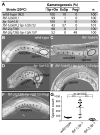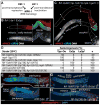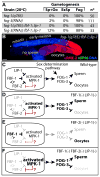MPK-1/ERK regulatory network controls the number of sperm by regulating timing of sperm-oocyte switch in C. elegans germline
- PMID: 28782521
- PMCID: PMC5581679
- DOI: 10.1016/j.bbrc.2017.08.014
MPK-1/ERK regulatory network controls the number of sperm by regulating timing of sperm-oocyte switch in C. elegans germline
Abstract
The precise regulation of germline sexual fate is crucial for animal fertility. In C. elegans, the production of either type of gamete, sperm or oocyte, becomes mutually exclusive beyond the larval stage. Hermaphrodites initially produce sperm and then switch to produce oocytes. This change of fate during germline development is tightly controlled by several regulators. In C. elegans hermaphrodites, FBF-1 and FBF-2 (>95% identical, members of the Pumilio RNA-binding protein family) proteins function redundantly to promote the sperm-oocyte switch. Here, we demonstrate that loss of LIP-1 (dual specificity phosphatase) in fbf-1(ok91) single mutants leads to excess sperm production due to a delayed sperm-oocyte switch. This phenotype was dramatically rescued by depletion of MPK-1 (an ERK homolog). In contrast, loss of LIP-1 in fbf-2(q738) single mutants leads to a premature sperm-oocyte switch and loss of sperm. Notably, fbf-1 fbf-2; lip-1 triple mutants produce excess sperm. These results suggest that the MPK-1/ERK regulatory network, including FBF-1, FBF-2, and LIP-1, controls the number of sperm by regulating the timing of the sperm-oocyte switch in C. elegans.
Keywords: Caenorhabditis elegans; FBF RNA-binding proteins; LIP-1; MPK-1/ERK; Sperm number; Sperm-oocyte switch.
Copyright © 2017 Elsevier Inc. All rights reserved.
Figures




Similar articles
-
Reevaluation of the role of LIP-1 as an ERK/MPK-1 dual specificity phosphatase in the C. elegans germline.Proc Natl Acad Sci U S A. 2022 Jan 18;119(3):e2113649119. doi: 10.1073/pnas.2113649119. Proc Natl Acad Sci U S A. 2022. PMID: 35022236 Free PMC article.
-
Redundant control of the Caenorhabditis elegans sperm/oocyte switch by PUF-8 and FBF-1, two distinct PUF RNA-binding proteins.Proc Natl Acad Sci U S A. 2005 Aug 2;102(31):10893-7. doi: 10.1073/pnas.0504593102. Epub 2005 Jul 21. Proc Natl Acad Sci U S A. 2005. PMID: 16037210 Free PMC article.
-
GLS-1, a novel P granule component, modulates a network of conserved RNA regulators to influence germ cell fate decisions.PLoS Genet. 2009 May;5(5):e1000494. doi: 10.1371/journal.pgen.1000494. Epub 2009 May 22. PLoS Genet. 2009. PMID: 19461891 Free PMC article.
-
Role of PUF-8/PUF protein in stem cell control, sperm-oocyte decision and cell fate reprogramming.J Cell Physiol. 2014 Oct;229(10):1306-11. doi: 10.1002/jcp.24618. J Cell Physiol. 2014. PMID: 24638209 Review.
-
Sex determination in the Caenorhabditis elegans germline.Adv Exp Med Biol. 2013;757:41-69. doi: 10.1007/978-1-4614-4015-4_3. Adv Exp Med Biol. 2013. PMID: 22872474 Review.
Cited by
-
Testosterone Mediates Reproductive Toxicity in Caenorhabditis elegans by Affecting Sex Determination in Germ Cells through nhr-69/mpk-1/fog-1/3.Toxics. 2024 Jul 10;12(7):502. doi: 10.3390/toxics12070502. Toxics. 2024. PMID: 39058154 Free PMC article.
-
Two classes of active transcription sites and their roles in developmental regulation.Proc Natl Acad Sci U S A. 2020 Oct 27;117(43):26812-26821. doi: 10.1073/pnas.2013163117. Epub 2020 Oct 8. Proc Natl Acad Sci U S A. 2020. PMID: 33033228 Free PMC article.
-
Distinct roles of two eIF4E isoforms in the germline of Caenorhabditis elegans.J Cell Sci. 2020 Mar 30;133(6):jcs237990. doi: 10.1242/jcs.237990. J Cell Sci. 2020. PMID: 32079657 Free PMC article.
-
Regulation of germ cell development by ARI1 family ubiquitin ligases in C. elegans.Sci Rep. 2018 Dec 10;8(1):17737. doi: 10.1038/s41598-018-35691-y. Sci Rep. 2018. PMID: 30531803 Free PMC article.
-
Subunits of the DNA polymerase alpha-primase complex promote Notch-mediated proliferation with discrete and shared functions in C. elegans germline.FEBS J. 2018 Jul;285(14):2590-2604. doi: 10.1111/febs.14512. Epub 2018 May 28. FEBS J. 2018. PMID: 29775245 Free PMC article.
References
-
- Ellis RE. Sex determination in the Caenorhabditis elegans germ line. Curr Top Dev Biol. 2008;83:41–64. - PubMed
-
- Zhang B, Gallegos M, Puoti A, Durkin E, Fields S, Kimble J, Wickens MP. A conserved RNA-binding protein that regulates sexual fates in the C. elegans hermaphrodite germ line. Nature. 1997;390:477–484. - PubMed
-
- Kraemer B, Crittenden S, Gallegos M, Moulder G, Barstead R, Kimble J, Wickens M. NANOS-3 and FBF proteins physically interact to control the sperm-oocyte switch in Caenorhabditis elegans. Curr Biol. 1999;9:1009–1018. - PubMed
MeSH terms
Substances
Grants and funding
LinkOut - more resources
Full Text Sources
Other Literature Sources
Miscellaneous

